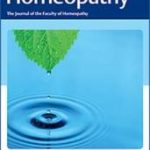Manju Lata Rao, Rustum Roy, Iris R. Bell and Richard Hoover
The defining role of structure (including epitaxy) in the plausibility of homeopathy
Homeopathy, 2007, 96 (3), 175-182

The key stumbling block to serious consideration of homeopathy is the presumed âimplausibilityâ? of biological activity for homeopathic medicines in which the source material is diluted past Avogadro's number of molecules. Such an argument relies heavily on the assumptions of elementary chemistry (and biochemistry), in which the material composition of a solution, (dilution factors and ligandâreceptor interactions), is the essential consideration.In contrast, materials science focuses on the three-dimensional complex network structure of the condensed phase of water itself, rather than the original solute molecules. The nanoheterogenous structure of water can be determined by interactive phenomena such as epitaxy (the transmission of structural information from the surface of one material to another without the transfer of any matter), temperatureâpressure processes during succussion, and formation of colloidal nanobubbles containing gaseous inclusions of oxygen, nitrogen, carbon dioxide, and possibly the remedy source material.Preliminary data obtained using Raman and Ultra-VioletâVisible (UVâVIS) spectroscopy illustrate the ability to distinguish two different homeopathic medicines (Nux vomica and Natrum muriaticum) from one another and to differentiate, within a given medicine, the 6c, 12c, and 30c potencies. Materials science concepts and experimental tools offer a new approach to contemporary science, for making significant advances in the basic science studies of homeopathic medicines.





